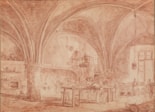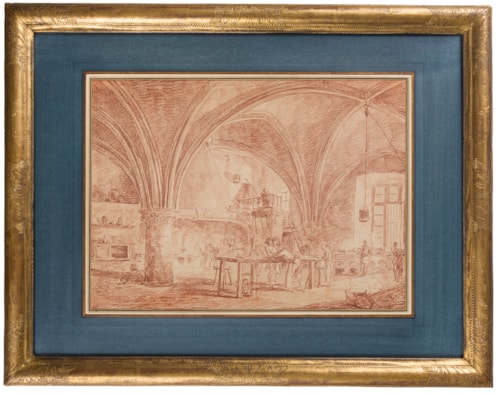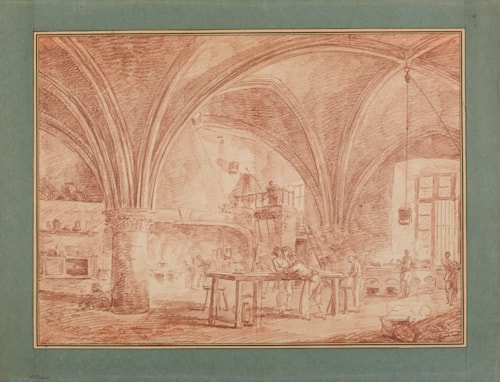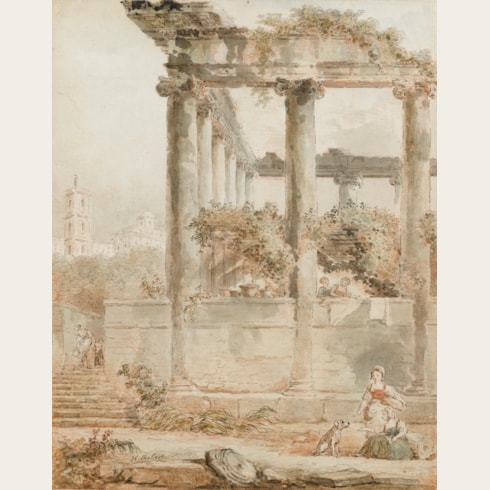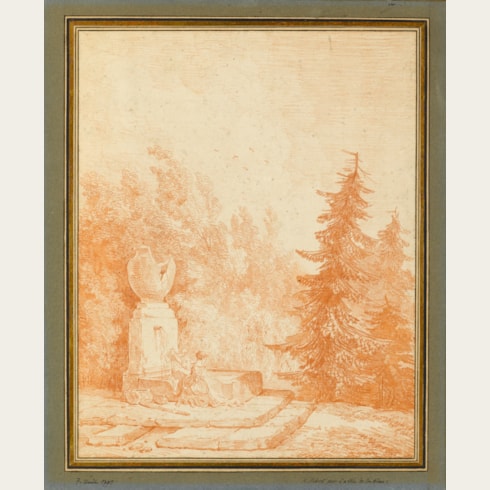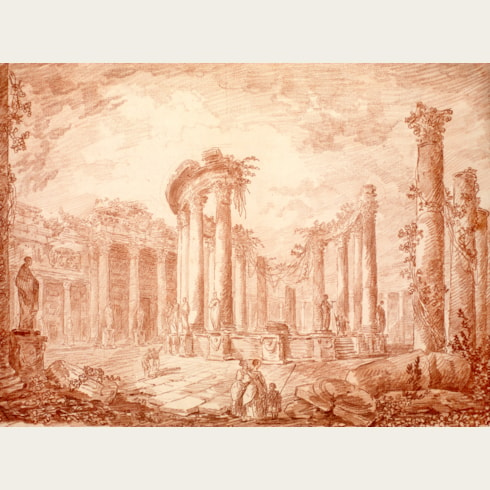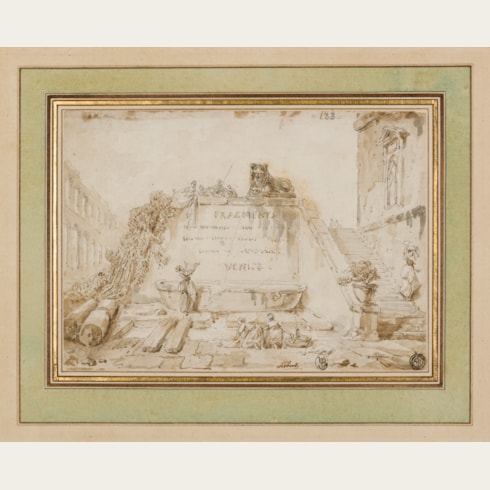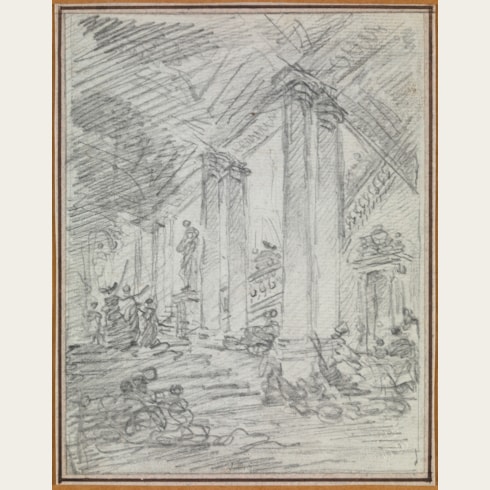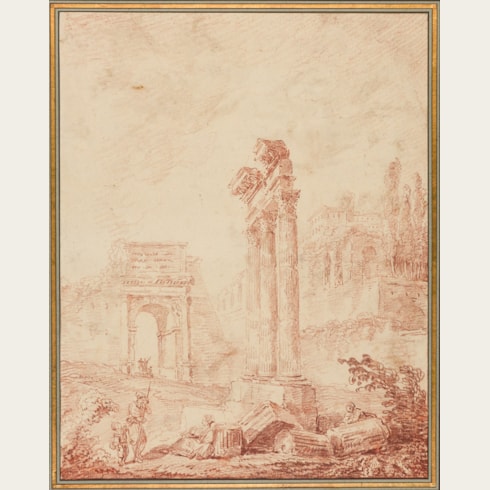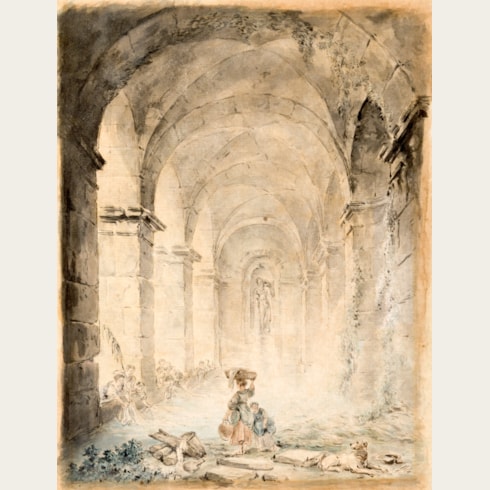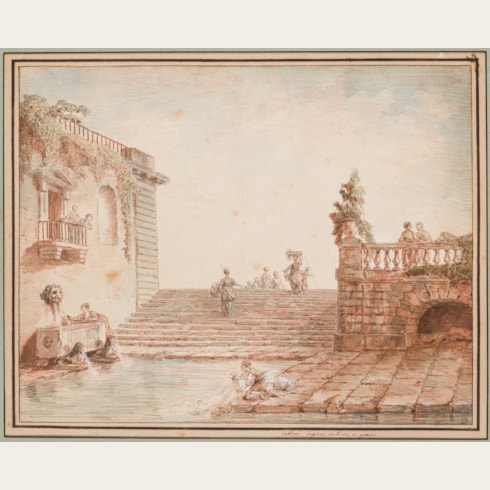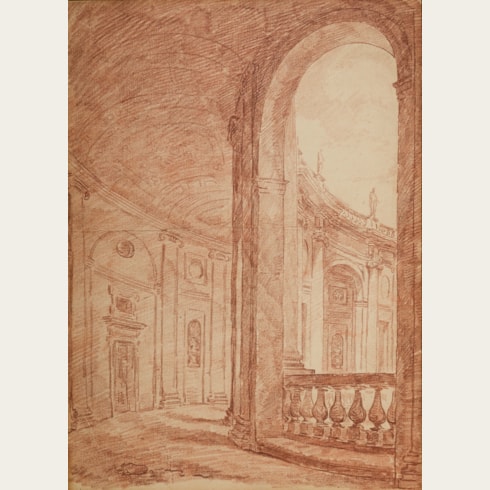Hubert ROBERT
(Paris 1733 - Paris 1808)
A Kitchen in a Vaulted Hall
Laid down on a late 19th century French mount.
Inscribed H. Robert. and numbered -5 at the lower left of the old mount, along with other inscriptions cut off at the bottom edge of the mount.
Further inscribed (by Deglatigny) Ce dessin paraît avoir été fait vers 1758 dans la salle des gardes, aujourdhui le grande guichet de la Conciergerie. Vente Roblin 26 fevrier 1900. on the reverse of the old mount.
335 x 460 mm. (13 1/4 x 18 1/8 in.)
A counterproof of this drawing is today in the Bibliothèque Municipale in Besançon, part of a group of nearly two hundred counterproofs by Robert divided between the collections of the Bibliothèque Municipale and the Musée des Beaux-Arts et d’Archaéologie in Besançon. Robert often made counterproofs of his drawings in both red and black chalk; this was an essential task, since by making a counterproof, any excess chalk dust – which otherwise might easily smear - would be removed from the original drawing. Counterproofs also served the artist as records of successful compositions. At times Robert would sell the counterproof and keep the original drawing for himself, while at other times he would extensively rework the counterproof with chalk, ink or watercolour to create a finished, reversed version of the original composition. Furthermore, as Grasselli has noted of the artist, ‘Upon occasion, he made replicas of his sanguines, usually with some variations; presumably these copies had been requested by patrons or were easily saleable.’ Indeed, a close copy or variant of the present composition, drawn in red chalk and of similar dimensions, appeared at auction in Paris in 1929.
The Rouen merchant and archaeologist Louis Deglatigny (1854-1936) assembled an extensive collection of paintings, drawings, books and prints, including a significant number of drawings by Hubert Robert. Although much of Deglatigny’s collection was dispersed over five auctions in Paris in 1937, the year after his death, the present sheet remained with his descendants until 2019.
A student of the sculptor Michel-Ange Slodtz, Hubert Robert travelled to Rome in 1754 in the retinue of the new French ambassador to the Vatican, the future Duc de Choiseul. It was probably through the influence of Choiseul that, although he was not officially a pensionnaire at the Académie de France in Rome, the young Robert was able to study there for several years. Succinctly described by the director of the Académie de France, Charles-Joseph Natoire, as a young man ‘who has a penchant for painting architecture’ (‘qui a du goût pour peindre l’architecture’), Robert spent a total of eleven years in Italy, mostly in Rome. He fell under the particular influence of Giovanni Paolo Panini, the leading Italian painter of architectural views and capricci, who taught perspective at the Académie de France. Robert’s earliest paintings and drawings, both in composition and technique, are greatly indebted to the example of Panini. At the Académie de France Robert met and befriended Jean-Honoré Fragonard, and with him made sketching tours of the countryside around Rome.
Robert returned to Paris in 1765, and the following year was admitted into the Académie Royale as a ‘peintre des ruines’, rather unusually being both reçu and agrée in the same year. He made his debut at the Salon in 1767, exhibiting picturesque landscapes and capricci, and soon had developed such a reputation for paintings of real and imagined Roman views, often incorporating ancient ruins, that he was given the sobriquet ‘Robert des Ruines’. A versatile artist, Robert often repeated and developed favourite views or compositions in several different formats, including chalk drawings, finished watercolours, small cabinet pictures and large-scale wall paintings. Appointed dessinateur des jardins du roi in 1778, Robert was also able to incorporate his artistic ideas into his landscape designs for gardens at Versailles and elsewhere. Despite being imprisoned during the Revolution, he remained a significant figure in the artistic scene in Paris until the end of the century.
Provenance
Louis Deglatigny, Rouen (Lugt 1768a)
His posthumous sale, Paris, Galerie Jean Charpentier, 28 May 1937, lot 96 (Cuisines dans un sale voutée, probablement des cuisines du Palais de Justice. Un grand chaudron est suspendu à la crémaillère d’une vaste cheminée, au milieu du fond. A droite, près d’une haute fenêtre, un grand fourneau où fument plusieurs casseroles. Des cuisiniers s’affairent devant les feux; on en voit quatre autres au milieu du premier plan, près d’une haute et longue table. A gauche, deux chiens attachés au gros pilier roman qui soutient les voûtes et, à droite, un grand chaudron avec son couvercle. Sanguine. Monture ancienne. Haut., 0 m. 335; Larg., 0 m. 460., unsold?)
Anonymous sale, Versailles, Hôtel des Chevau-Légers, 25 November 1962, lot 25 (unsold?)
By descent to Deglatigny’s great-grandson, Jean-Claude Delauney, Caen.
Literature


